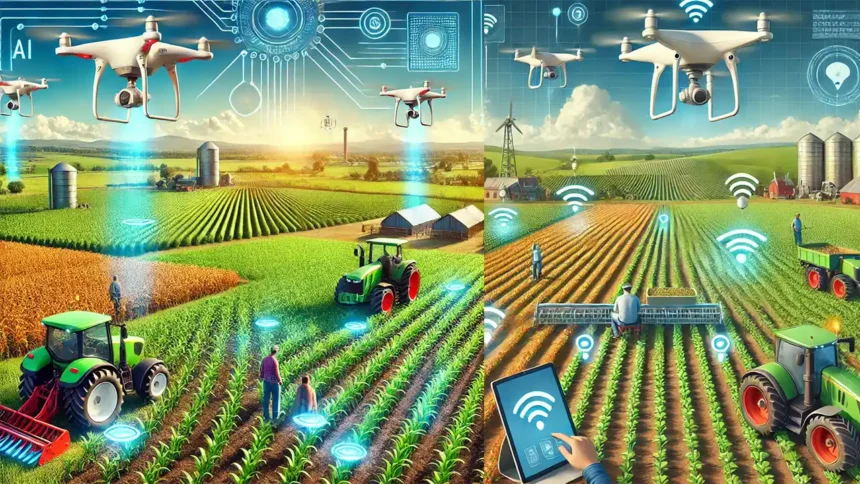Sustainable Future and Role of Artificial Intelligence in Agriculture
Agriculture is one of the oldest industries in the world, feeding people and providing resources for many centuries. But, as the global population grows, traditional farming methods are struggling to keep up. Today, we face the challenge of feeding a larger population, dealing with climate change, and using limited resources efficiently. Here, artificial intelligence (AI) has stepped in to transform agriculture. With advanced technology, AI can help farmers improve crop yields, reduce waste, and manage resources better.
In this post, we will explore the Role of Artificial Intelligence in Agriculture, looking at the different ways it is used in the field, its benefits, challenges, and how it impacts the future of farming.
The Role of Artificial Intelligence in Agriculture
1. Precision Farming with AI
Precision farming is a method that uses technology to make farming more accurate and controlled. It involves gathering detailed information about crops and soil, allowing farmers to make informed decisions. With AI, precision farming has become more effective and accessible.
- Data Collection: AI-powered drones and sensors collect data on soil health, crop conditions, and weather patterns. This data helps farmers know exactly what each part of their field needs, whether it’s water, fertilizer, or pest control.
- Crop Monitoring: AI-powered apps and tools allow farmers to monitor crops remotely. They can spot signs of diseases or nutrient deficiencies early, preventing crop loss and improving yields.
2. Predictive Analytics for Better Crop Management
AI is also used to predict agricultural trends and weather patterns, which is crucial for planning and crop management. By analyzing large sets of historical data, AI algorithms can predict future trends with impressive accuracy.
- Weather Forecasting: Accurate weather forecasting helps farmers plan their activities, like planting or harvesting, at the best times.
- Yield Prediction: AI models can estimate crop yield based on factors like soil quality, weather, and crop type. This helps farmers plan resources effectively.
3. Pest and Disease Management
Pests and diseases can destroy crops and cause huge losses for farmers. AI technology helps detect pests and diseases early, allowing farmers to take action before the damage becomes severe.
- Image Recognition: AI-based image recognition tools can identify pests and diseases by analyzing pictures of plants. These tools are often available as mobile apps, making them easily accessible.
- Pest Control Solutions: Some AI tools can recommend the best pest control measures based on specific pests or diseases, saving farmers time and resources.
4. Autonomous Farming Equipment
Self-driving tractors, drones, and robots are becoming more common in agriculture, thanks to AI. These machines can perform tasks like planting, watering, and harvesting, saving time and labor costs.
- Tractor Automation: AI-powered tractors can work in fields without human assistance. They can plow, sow seeds, and even spray pesticides accurately, ensuring that resources are used efficiently.
- Robots for Harvesting: Harvesting robots use AI to identify ripe fruits and vegetables, picking them with precision to reduce waste. This is especially helpful for crops like strawberries, where timing and handling are essential.
5. Soil and Water Management
Managing soil health and water use is critical in agriculture. AI helps farmers understand their soil better and make the best use of water resources.
- Soil Analysis: AI-powered sensors analyze soil properties, such as moisture and nutrients. This information helps farmers know when and how much to fertilize.
- Smart Irrigation Systems: AI systems can automate irrigation by analyzing weather data and soil moisture levels. This ensures that crops get the right amount of water, saving resources and protecting the environment.
Benefits of Using AI in Agriculture
AI brings several benefits to agriculture, helping farmers work smarter, not harder. Here are some key advantages:
- Increased Efficiency: AI reduces the need for manual labor, saving time and money.
- Higher Yields: Precision farming and better resource management lead to higher crop yields.
- Cost Savings: By using resources more efficiently, AI helps reduce costs for things like water, fertilizer, and pest control.
- Sustainability: AI encourages sustainable farming practices, reducing waste and protecting the environment.
- Better Decision-Making: With accurate data and insights, farmers can make smarter decisions about their crops and fields.
Challenges in Implementing AI in Agriculture
Despite its benefits, AI in agriculture faces some challenges that need to be addressed for successful adoption.
1. High Costs of AI Technology
The initial cost of AI technology, such as drones, sensors, and automated machines, can be high. Small-scale farmers may find it difficult to afford these tools without support from governments or organizations.
2. Data Privacy Concerns
AI in agriculture collects a large amount of data, raising concerns about data privacy and security. Farmers worry that their data may be misused or shared without consent.
3. Lack of Skilled Workers
Using AI Agricultural tools requires some technical skills. Many farmers, especially in rural areas, lack the necessary training to operate AI devices effectively.
4. Connectivity Issues in Rural Areas
Many rural farming areas have limited internet access, which is necessary for certain AI technologies to function properly. Without strong connectivity, farmers may struggle to use AI-powered tools.
Future of AI in Agriculture
The future of AI in agriculture is promising. As technology continues to advance, we can expect more affordable and accessible AI tools for farmers. In the future, AI could play an even bigger role in sustainable farming practices, such as reducing chemical use and conserving water. With AI, farmers will be able to produce more food with fewer resources, addressing global food security challenges.
Conclusion
Artificial intelligence is transforming agriculture, offering solutions to many of the industry’s biggest challenges. From precision farming to pest management, AI is helping farmers increase productivity, save resources, and work sustainably. While challenges like high costs and connectivity issues exist, the benefits of AI in agriculture are clear. As technology progresses, AI will become even more important in ensuring a secure and sustainable food future.
FAQs
How is AI used in agriculture?
AI is used in agriculture for tasks like crop monitoring, pest control, weather forecasting, and soil management. It helps farmers make better decisions and work more efficiently.
What are the benefits of AI in farming?
AI in farming leads to higher crop yields, cost savings, efficient resource use, and sustainable practices, making agriculture more productive and eco-friendly.
What are the challenges of AI in agriculture?
High costs, data privacy concerns, lack of skilled workers, and connectivity issues are some of the main challenges in implementing AI in agriculture.
Can small-scale farmers use AI technology?
Yes, although it may be more challenging due to cost, some AI tools, like mobile apps for crop monitoring, are accessible to small-scale farmers.
How does AI improve crop yields?
AI improves crop yields by providing data-driven insights for better soil management, pest control, and precise watering, which leads to healthier crops and higher productivity.





